Industrial Motors Market Size
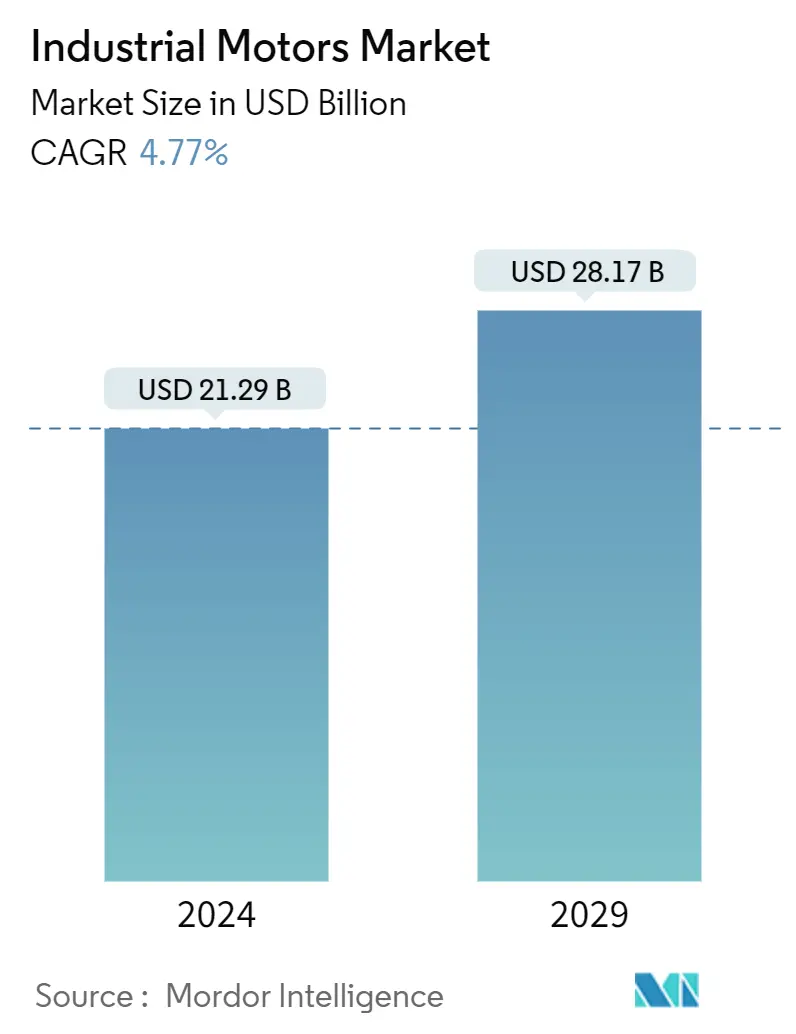
| Study Period | 2019 - 2029 |
| Market Size (2024) | USD 21.29 Billion |
| Market Size (2029) | USD 28.17 Billion |
| CAGR (2024 - 2029) | 4.77 % |
| Fastest Growing Market | Asia-Pacific |
| Largest Market | Asia Pacific |
Major Players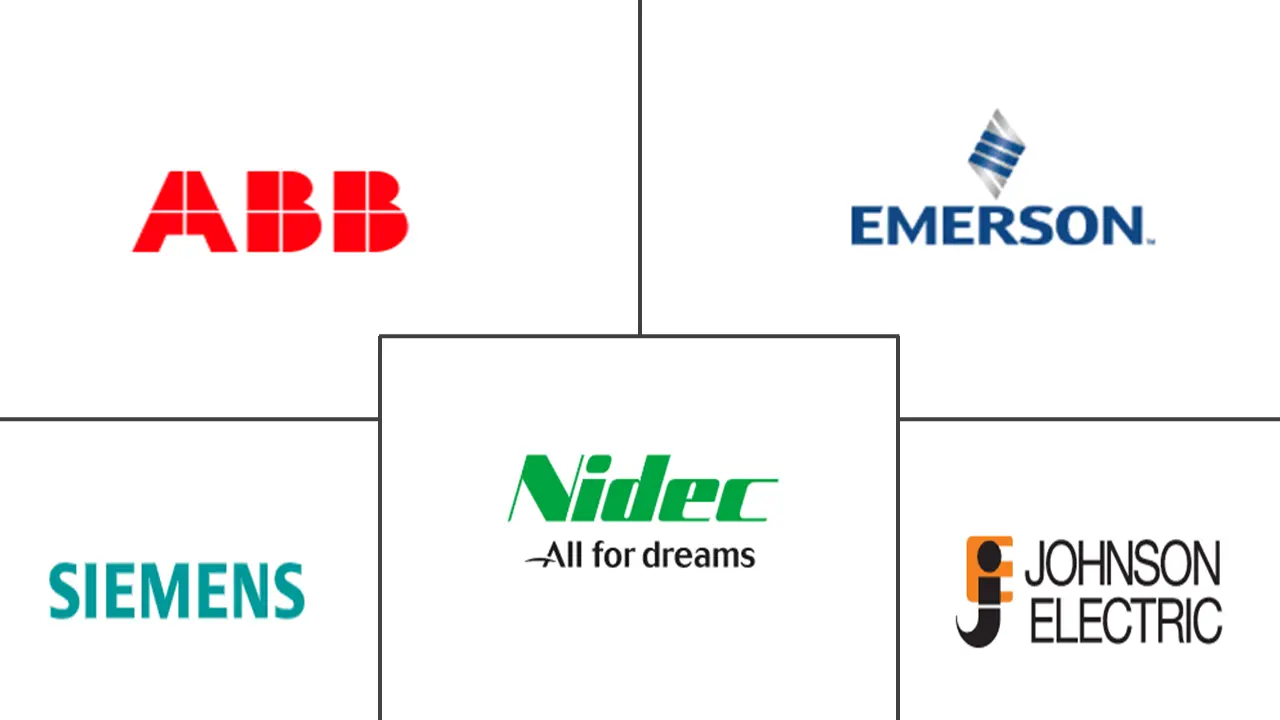
*Disclaimer: Major Players sorted in no particular order |
Industrial Motors Market Analysis
The Industrial Motors Market size is estimated at USD 21.29 billion in 2024, and is expected to reach USD 28.17 billion by 2029, growing at a CAGR of 4.77% during the forecast period (2024-2029).
The expanding footprint of the industrial sector across developing regions, along with the growing penetration of advanced machinery and automation, supports the studied market's growth.
- Motors are the significant driving force of industrial production. The new and advanced approaches for designing and developing industrial motors include factors like alignment, motor monitoring, connections, testing, and saving costs and time while improving safety and security. Energy-saving motors and intelligent drives also boost efficiency and performance while facilitating troubleshooting.
- The growing focus on Industry 4.0 primarily drives the market for industrial motors. Industrial automation drives the manufacturing sector toward more productivity in several regions, expecting to show strong demand. According to Industrial Energy Accelerator, nearly 70% of all electrical energy consumed by several industries is used by the millions of electrical motors installed globally. Such trends drive the demand for innovations in industrial motor technology to make them energy efficient.
- The industry players also focus on expanding their manufacturing operations, further supporting the market growth. For instance, in July 2022, Mitsubishi Electric Corporation revealed that it would fund the construction of a new factory in India by investing roughly JPY 3.1 billion (USD 20753139), or EUR 21.8 million (USD 23078570), in its subsidiary Mitsubishi Electric India Pvt. Ltd. The new facility, whose activities are scheduled to begin in December 2023, will likely produce inverters and other factory automation (FA) control system goods, enhancing the company's capacity to satisfy India's booming demand. Such an instance will create a favorable outlook for the growth of the studied market in the region.
- In Industrial applications, AC motors are generally more reliable with low maintenance requirements, and the bearing life frequently limits the service life of AC motors. Since the motors do not need commutators, brushes, or slip rings, they don't have parts that wear out regularly. This factor makes the motors ideal for applications that are not easily accessible, continuously available to operate, or will work without supervision for long periods. Furthermore, one critical trend in the market is the development of high power-to-weight ratio industrial motors. Several manufacturers are developing electric motors with a high power-to-weight ratio, as large electric motors have portability and high energy consumption issues.
- However, factors such as the higher installation and maintenance cost of industrial motors challenge the growth of the studied market, especially in developing markets, wherein price sensitivity is higher.
- The impact of macroeconomic factors is also on the higher side in the studied market, as investments in the industrial sector are largely influenced by factors such as the market demand for manufactured products, the general economic condition of the region, and the geopolitical situation. Hence, during the forecast period, these factors are anticipated to continue to play a pivotal role in determining the growth trajectory of the studied market.
Industrial Motors Market Trends
Low Voltage to Hold Significant Market Share
- The industry standards for low-voltage motors vary broadly. Several manufacturers have different motor classifications that are considered low-voltage motors. According to the IEC 600038 standard (International Electrotechnical Commission's), any motor rating up to 1000 volts is regarded as a low voltage (LV).
- Compared to other motors in the market, low-voltage engines have a wide range of applications across multiple industries. Some of the primary applications of low-voltage motors are in the mid-stream and downstream oil and gas, water, wastewater, food, and beverage industries, etc.
- Multi-purpose low voltage motors provide simple installation and quick start and have an affordable standardized design with high productivity, high reliability, increased safety, and very efficient electricity use. Low-voltage motors can also be designed for applications without a specially developed engine. The European Commission Ecodesign Regulation recently addressed this for low-voltage motors by enforcing and establishing (IE) International Efficiency classes defined by the IEC (International Electrotechnical Commission). It set IE3 as the minimum standard and IE5 as a unique ultra-premium rating, including motors with variable-speed drives.
- Additionally, over the forecast period, rising oil prices are expected to create a strong rebound demand for LV motors from the oil and gas industry. For instance, according to OPEC, crude oil demand in the OPEC member countries is anticipated to grow from 8.1 million barrels per day to 12 million barrels per day by 2045. Considering such trends, companies are now focusing on developing low-voltage motor solutions for the oil and gas sector to grab emerging opportunities, creating a favorable outlook for the growth of the studied market.
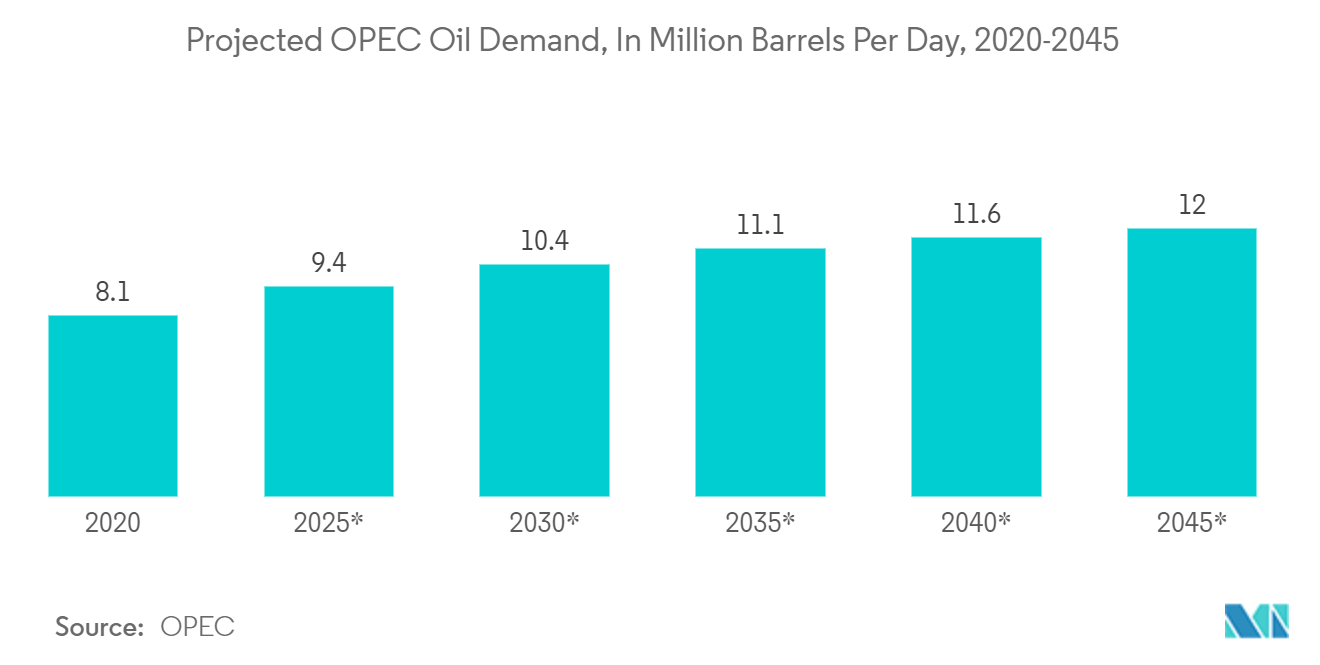
Asia-Pacific to Witness Significant Growth
- Manufacturing is one of the pillars of several countries of the Asia Pacific region, specifically of the Chinese economy, and is undergoing a rapid transformation. This large-scale transformation has put the country in a leading position in the market. Over the last two decades, Chinese manufacturers have evolved their capabilities from producing low-cost goods to creating more advanced products, wherein competent industrial machinery and motors remain pivotal.
- The adoption of industrial motors in the country is also expected to be driven by smart manufacturing initiatives. According to the Ministry of Industry and Information Technology, the Chinese government initiated several smart manufacturing pilot projects. As per the 13th five-year plan, the country aims to establish its intelligent manufacturing system and complete the critical industry transformation by 2025. As a result of such initiatives, automakers have been expanding their manufacturing facilities in China, creating a favorable outlook for the demand for industrial motors during the forecast period.
- A similar trend has been observed across other countries. For instance, the government of India, in October 2022, announced that it put up 42 oil and gas blocks for exploration and development through international competitive bidding. India will more than double the area under investigation and production of oil and gas to 0.5 million square kilometers by 2025 and 1 million sq. km. by 2030, intending to raise domestic output and cut reliance on imported fuel, thus creating a favorable outlook for demand for industrial motors in the oil and gas industry as industrial motors play a vital role in the upstream of the oil and gas industry and are widely used to drive equipment such as pump and compressor systems.
- Furthermore, in recent years, the industrial sector in Southeast Asia has also flourished significantly, driven by the growing investment by MNCs exploring destinations outside China. Countries such as Thailand, Malaysia, and Indonesia are fast emerging among the leading industrialized economies in the region, which is anticipated to favor the studied market's growth in Southeast Asia during the forecast period.
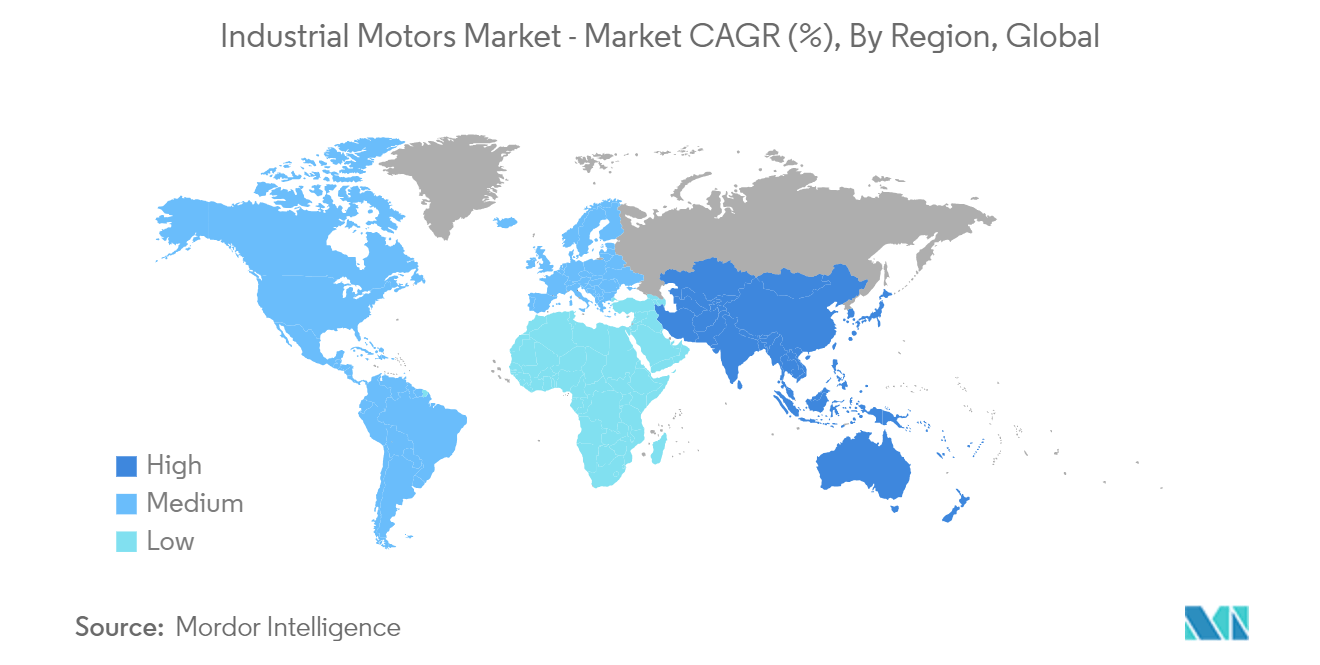
Industrial Motors Industry Overview
The industrial motor market is moving towards a fragmented stage, owing to the presence of a large number of companies, such as the ABB Group, Siemens AG, Emerson Electric Co. Inc., and Johnson Electric. Through innovation, sustainable competitive advantage can be attained, but it has become increasingly challenging for firms to differentiate themselves from market competition. Because the concentration of suppliers is high, buyers can choose among different vendors. Although the market comprises various players, a handful of them are still prominent for their high standards, excellent quality, and global reach.
In July 2023, Electrified Automation launched a new range of electric motors. The new motor architecture is designed to maximize the potential of automation and high-volume production for OEMs looking for a reliable, responsive supply chain. Furthermore, the new EA 193 Series permanent magnet electric motors will support a range of applications from industrial to two-wheel-on-road.
In June 2023, ABB developed the new generation AMI 5800 NEMA modular induction motor. Designed to offer reliability and energy efficiency in demanding applications such as pumps, fans, compressors, extruders, conveyors, and crushers, the AMI 5800 motor's power output of up to 1750 HP offers the capability of a high degree of customization and modularity to suit applications in a wide range of industries including mining, chemical oil and gas, conventional power generation, and cement and metals.
Industrial Motors Market Leaders
-
ABB Ltd.
-
Emerson Electric Co.
-
Nidec Industrial Solutions
-
Johnson Electric Holdings Limited
-
Siemens AG
*Disclaimer: Major Players sorted in no particular order
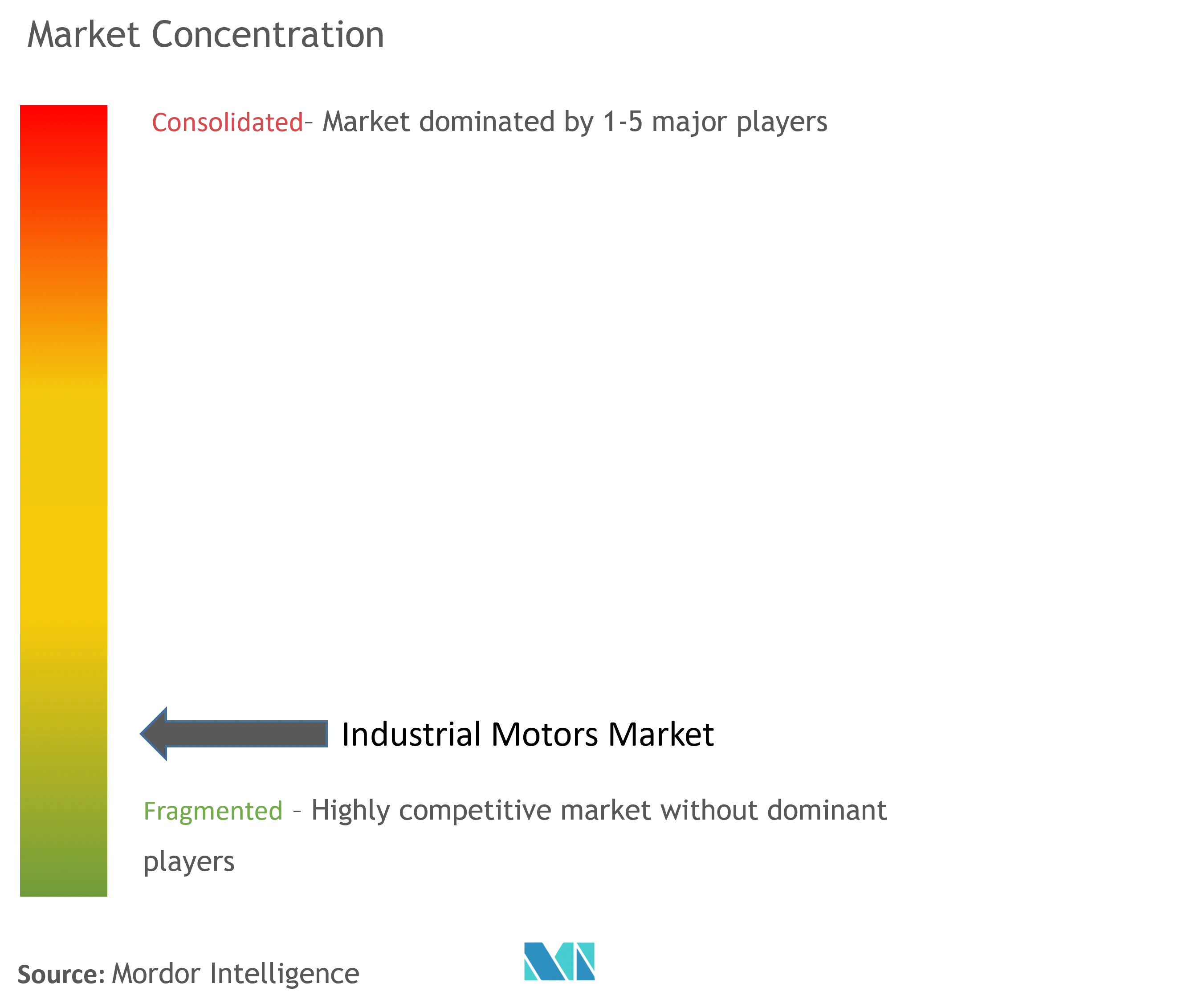
Industrial Motors Market News
- May 2023: ABB announced the completion of its acquisition of the Siemens low voltage NEMA motor business. According to the company, the acquisition is part of ABB's Motion business area's growth strategy and strengthens ABB's position among the leading industrial NEMA motor manufacturers.
- March 2023: Siemens combined its business activities in the areas of low- to high-voltage motors, medium-voltage converters, geared motos, and motor spindles under a new company called "Innomotics." The company announced that Innomotics will start operating as a legally separate company in Germany by July 2023.
- September 2022: Mitsubishi Electric collaborated with TMEIC to develop an electrical motor design support system. It incorporates Mitsubishi Electric's Maisart AI technology to dampen the time required to produce unique electrical motor designs that achieve the same performance as conventional design methods deployed manually by skilled and highly experienced engineers. TMEIC (Toshiba Mitsubishi-Electric Industrial Systems Corporation) plans to adopt the system for internal operations by 2024. The newly developed system can design electrical motors for industrial pumps, compressors, and fan applications.
Industrial Motors Market Report - Table of Contents
1. INTRODUCTION
- 1.1 Study Assumptions and Market Definition
- 1.2 Scope of the Study
2. RESEARCH METHODOLOGY
3. EXECUTIVE SUMMARY
4. MARKET INSIGHTS
- 4.1 Market Overview
-
4.2 Industry Attractiveness - Porter's Five Forces Analysis
- 4.2.1 Bargaining Power of Suppliers
- 4.2.2 Bargaining Power of Buyers/Consumers
- 4.2.3 Threat of New Entrants
- 4.2.4 Threat of Substitute Products
- 4.2.5 Intensity of Competitive Rivalry
- 4.3 Impact of Macro Trends on the Industrial Motors Market
5. MARKET DYNAMICS
-
5.1 Market Drivers
- 5.1.1 Demand for Energy Efficiency Owing to Government Regulations
- 5.1.2 Growing Shift towards Smart Motors
-
5.2 Market Challenges
- 5.2.1 Portability Issues
- 5.2.2 High Initial Investment for Procuring New Equipment and Upgrading Existing Equipment
6. MARKET SEGMENTATION
-
6.1 By Type of Motor
- 6.1.1 Alternating Current (AC) Motors
- 6.1.2 Direct Current (DC) Motor
- 6.1.3 Other Types of Motors (Servo and Electronically Commutated Motors (EC))
-
6.2 By Voltage
- 6.2.1 High Voltage
- 6.2.2 Medium Voltage
- 6.2.3 Low Voltage
-
6.3 By End User
- 6.3.1 Oil and Gas
- 6.3.2 Power Generation
- 6.3.3 Mining and Metals
- 6.3.4 Water and Wastewater Management
- 6.3.5 Chemicals and Petrochemicals
- 6.3.6 Discrete Manufacturing
- 6.3.7 Other End Users
-
6.4 By Geography
- 6.4.1 North America
- 6.4.1.1 United States
- 6.4.1.2 Canada
- 6.4.2 Europe
- 6.4.2.1 United Kingdom
- 6.4.2.2 Germany
- 6.4.2.3 France
- 6.4.2.4 Rest of Europe
- 6.4.3 Asia-Pacific
- 6.4.3.1 China
- 6.4.3.2 Japan
- 6.4.3.3 India
- 6.4.3.4 Rest of Asia-Pacific
- 6.4.4 Latin America
- 6.4.4.1 Brazil
- 6.4.4.2 Argentina
- 6.4.4.3 Rest of Latin America
- 6.4.5 Middle East and Africa
- 6.4.5.1 Saudi Arabia
- 6.4.5.2 South Africa
- 6.4.5.3 Rest of Middle East and Africa
7. COMPETITIVE LANDSCAPE
-
7.1 Company Profiles*
- 7.1.1 ABB Ltd.
- 7.1.2 Emerson Electric Co.
- 7.1.3 Siemens
- 7.1.4 Nidec Industrial Solutions
- 7.1.5 Johnson Electric Holdings Limited
- 7.1.6 Arc Systems Inc.
- 7.1.7 Ametek Inc.
- 7.1.8 Toshiba Electronic Devices and Storage Corporation
- 7.1.9 Wolong Industrial Motors
- 7.1.10 Allen - Bradly Co. LLC (Rockwell Automation Inc.)
- 7.1.11 Maxon Motor AG
- 7.1.12 Franklin Electric Co. Inc.
- 7.1.13 Fuji Electric Co. Ltd
- 7.1.14 ATB Austria Antriebstechnik AG
- 7.1.15 Menzel Elektromotoren GmbH
8. INVESTMENT ANALYSIS
9. FUTURE OF THE MARKET
** Subject To AvailablityIndustrial Motors Industry Segmentation
An industrial motor is an electric motor that converts electricity into mechanical energy. These motors produce rotary or linear forces and are typically powered by alternating current (AC) resources such as power grids or generators. However, some may be supplied by direct current (DC) resources like batteries.
The industrial motors market is segmented by type of motor (alternating current (AC) motors, direct current (DC) motors), voltage (high voltage, medium voltage, low voltage), end-user (oil and gas, power generation, mining, and metals, water and wastewater management, chemicals and petrochemicals, discrete manufacturing), and by geography (North America, Europe, Asia-Pacific, Latin America, Middle East and Africa). The market sizes and forecasts are provided in terms of value (USD) for all the above segments.
| By Type of Motor | Alternating Current (AC) Motors | |
| Direct Current (DC) Motor | ||
| Other Types of Motors (Servo and Electronically Commutated Motors (EC)) | ||
| By Voltage | High Voltage | |
| Medium Voltage | ||
| Low Voltage | ||
| By End User | Oil and Gas | |
| Power Generation | ||
| Mining and Metals | ||
| Water and Wastewater Management | ||
| Chemicals and Petrochemicals | ||
| Discrete Manufacturing | ||
| Other End Users | ||
| By Geography | North America | United States |
| Canada | ||
| By Geography | Europe | United Kingdom |
| Germany | ||
| France | ||
| Rest of Europe | ||
| By Geography | Asia-Pacific | China |
| Japan | ||
| India | ||
| Rest of Asia-Pacific | ||
| By Geography | Latin America | Brazil |
| Argentina | ||
| Rest of Latin America | ||
| By Geography | Middle East and Africa | Saudi Arabia |
| South Africa | ||
| Rest of Middle East and Africa |
Industrial Motors Market Research FAQs
How big is the Industrial Motors Market?
The Industrial Motors Market size is expected to reach USD 21.29 billion in 2024 and grow at a CAGR of 4.77% to reach USD 28.17 billion by 2029.
What is the current Industrial Motors Market size?
In 2024, the Industrial Motors Market size is expected to reach USD 21.29 billion.
Who are the key players in Industrial Motors Market?
ABB Ltd., Emerson Electric Co., Nidec Industrial Solutions, Johnson Electric Holdings Limited and Siemens AG are the major companies operating in the Industrial Motors Market.
Which is the fastest growing region in Industrial Motors Market?
Asia-Pacific is estimated to grow at the highest CAGR over the forecast period (2024-2029).
Which region has the biggest share in Industrial Motors Market?
In 2024, the Asia Pacific accounts for the largest market share in Industrial Motors Market.
What years does this Industrial Motors Market cover, and what was the market size in 2023?
In 2023, the Industrial Motors Market size was estimated at USD 20.27 billion. The report covers the Industrial Motors Market historical market size for years: 2019, 2020, 2021, 2022 and 2023. The report also forecasts the Industrial Motors Market size for years: 2024, 2025, 2026, 2027, 2028 and 2029.
Industrial Motors Industry Report
Statistics for the 2024 Industrial Motors market share, size and revenue growth rate, created by Mordor Intelligence™ Industry Reports. Industrial Motors analysis includes a market forecast outlook for 2024 to 2029 and historical overview. Get a sample of this industry analysis as a free report PDF download.



